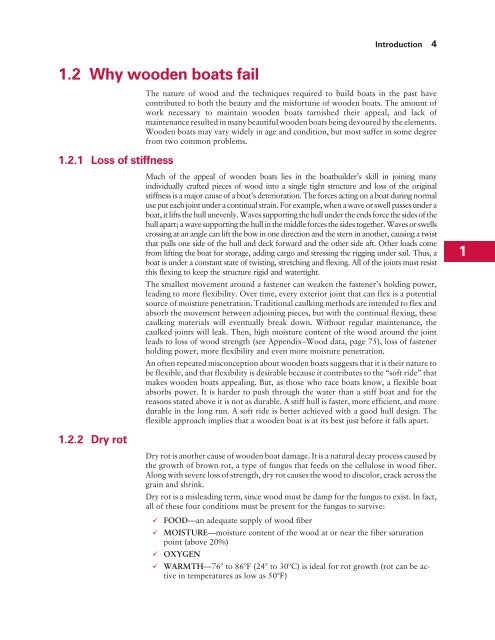Wooden Boat Restoration Repair - WEST SYSTEM Epoxy
Wooden Boat Restoration Repair - WEST SYSTEM Epoxy
Wooden Boat Restoration Repair - WEST SYSTEM Epoxy
You also want an ePaper? Increase the reach of your titles
YUMPU automatically turns print PDFs into web optimized ePapers that Google loves.
1.2 Why wooden boats fail<br />
1.2.1 Loss of stiffness<br />
1.2.2 Dry rot<br />
Introduction 4<br />
The nature of wood and the techniques required to build boats in the past have<br />
contributed to both the beauty and the misfortune of wooden boats. The amount of<br />
work necessary to maintain wooden boats tarnished their appeal, and lack of<br />
maintenance resulted in many beautiful wooden boats being devoured by the elements.<br />
<strong>Wooden</strong> boats may vary widely in age and condition, but most suffer in some degree<br />
from two common problems.<br />
Much of the appeal of wooden boats lies in the boatbuilder’s skill in joining many<br />
individually crafted pieces of wood into a single tight structure and loss of the original<br />
stiffness is a major cause of a boat’s deterioration. The forces acting on a boat during normal<br />
use put each joint under a continual strain. For example, when a wave or swell passes under a<br />
boat, it lifts the hull unevenly. Waves supporting the hull under the ends force the sides of the<br />
hull apart; a wave supporting the hull in the middle forces the sides together. Waves or swells<br />
crossing at an angle can lift the bow in one direction and the stern in another, causing a twist<br />
that pulls one side of the hull and deck forward and the other side aft. Other loads come<br />
from lifting the boat for storage, adding cargo and stressing the rigging under sail. Thus, a<br />
boat is under a constant state of twisting, stretching and flexing. All of the joints must resist<br />
this flexing to keep the structure rigid and watertight.<br />
The smallest movement around a fastener can weaken the fastener’s holding power,<br />
leading to more flexibility. Over time, every exterior joint that can flex is a potential<br />
source of moisture penetration. Traditional caulking methods are intended to flex and<br />
absorb the movement between adjoining pieces, but with the continual flexing, these<br />
caulking materials will eventually break down. Without regular maintenance, the<br />
caulked joints will leak. Then, high moisture content of the wood around the joint<br />
leads to loss of wood strength (see Appendix–Wood data, page 75), loss of fastener<br />
holding power, more flexibility and even more moisture penetration.<br />
An often repeated misconception about wooden boats suggests that it is their nature to<br />
be flexible, and that flexibility is desirable because it contributes to the “soft ride” that<br />
makes wooden boats appealing. But, as those who race boats know, a flexible boat<br />
absorbs power. It is harder to push through the water than a stiff boat and for the<br />
reasons stated above it is not as durable. A stiff hull is faster, more efficient, and more<br />
durable in the long run. A soft ride is better achieved with a good hull design. The<br />
flexible approach implies that a wooden boat is at its best just before it falls apart.<br />
Dry rot is another cause of wooden boat damage. It is a natural decay process caused by<br />
the growth of brown rot, a type of fungus that feeds on the cellulose in wood fiber.<br />
Along with severe loss of strength, dry rot causes the wood to discolor, crack across the<br />
grain and shrink.<br />
Dry rot is a misleading term, since wood must be damp for the fungus to exist. In fact,<br />
all of these four conditions must be present for the fungus to survive:<br />
FOOD—an adequate supply of wood fiber<br />
MOISTURE—moisture content of the wood at or near the fiber saturation<br />
point (above 20%)<br />
OXYGEN<br />
WARMTH—76° to 86°F (24° to 30°C) is ideal for rot growth (rot can be active<br />
in temperatures as low as 50°F)<br />
1
















